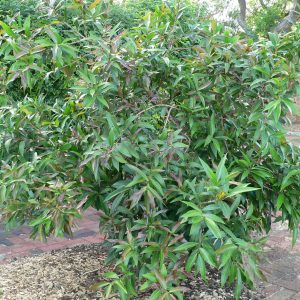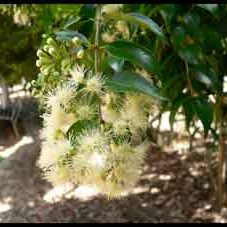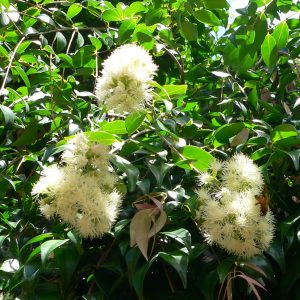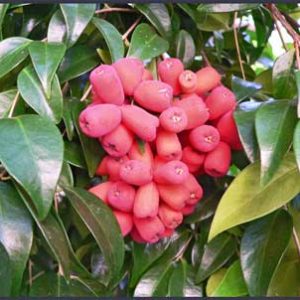Syzygium luehmannii
Riberry, small-leaved lilly pilly, cherry alder
Origin
The species is indigenous to New Guinea and sub-tropical Queensland and New South Wales. It’s an Australian bush food grown on a limited commercial scale (4-5t in 2012). Wild fruit represent a minor source sold at local farmers’ markets.
Climate
It is a sub-tropical plant that grows best in its native range of coastal, littoral and rainforest areas experiencing a wet summer/autumn and dry winter/spring. They can tolerate infrequent light frosts when reasonably mature. Higher summer temperatures impact flowering and fruiting, and undue radiation can also cause fruit sunburn. Once mature, plants in their preferred environment can fruit without irrigation, but very dry conditions are detrimental.
Plant Description
Riberry is an evergreen that can grow up to 30m in its native habitat but much less elsewhere or in monoculture (ie 5-10m). It has a handsome dense and rounded canopy. The mature glossy green leaves are simple, entire, opposite, ovate to lanceolate 2.5-7 x 1-3cm on a 2-4mm petiole, glabrous with a long acuminate apex and rounded base, and a paler lower surface. Leaves are pinkish when young. Without pruning (skirting), branches often droop to the ground.
Relatives
It is a member of the Myrtaceae family which has more than 3000 species characterised by their multi-locular fleshy- or dry-fruited berries. Of the 140 genera, Syzygium (estimated 1200-1500 species) and Eugenia are two of the largest, and these have historically proved difficult to separate taxonomically; traditionally this was largely achieved on flower characteristics, but these days relies increasingly on molecular sequence data. Some family relatives include pitanga, feijoa, grumichama, jaboticaba, guava, cherry guava and rose apple.
Soils
These can be moist sandy or clay-based, provided there is good drainage; extended waterlogging should be avoided. A pH of 5.5-6.5 is preferred along with good mulch levels.
Propagation
This is easy by seed or cuttings; the latter grow into much smaller plants than those from seedlings and may also produce seedless fruit.
Cultivars
Fledgling commercial development has resulted in some selected varieties and hybrids, eg Glover’s seedless, Cascade and Vic’s choice, but there is a need for more substantial breeding work.
Flowering and Pollination
Flowering occurs in late spring-early summer. Terminal inflorescences are compact panicles with short pedicels. The flowers are creamy white with 1-5-2.5mm long petals (4-5) and 2-5mm long stamens. Little is known about pollination but they seem to be self-fertile.
Cultivation
Best planted in full sun but will still grow in partial shade. Adequate moisture is necessary during the fruiting period. Nutrition requirements are not known in any detail, but it is presumed as an Australian native that it is sensitive to high P levels. NPK fertiliser should be restricted in spring to minimise undue vegetative growth at the expense of flowering, but a complete micronutrient spray may be beneficial at this time. Vegetative growth should be encouraged after harvest to form next year’s fruiting wood.
Wind Tolerance
It is not tolerant of strong winds, especially during flowering and fruiting.
Pruning
Plants should be pruned when young to establish a scaffold of 3-4 appropriately spaced branches. Pruning thereafter should endeavour to maximise light penetration throughout the dense canopy. Size should be controlled with periodic light pruning; heavy pruning may result in smaller yields for some years.
The Fruit
Fruit mature about 60 days after flowering and are obovoid or pyriform, 9-12 x 6-10mm, green when immature and turning pink-red when ripe. The juicy white flesh is tart and slightly acidic, and may have a solitary seed or be seedless if propagated vegetatively. Flavour is commonly described as being spicy, with hints of cinnamon and cloves. Blueberries are often regarded as having amongst the highest contents of healthy antioxidants in fruits, but riberry is in the same range and it exceeds blueberry vitamin C level.
Fruit Production and Harvesting
Cutting-grown trees may start producing their summer crop from the second year, seedlings in 3-5 years. Fruit ripen in a staged manner requiring multiple picking. Yields increase as plants mature and a well-managed plant may produce 50kg or more of fruit per season. Fruit can be stored in a crisper for up to 2 weeks and in a freezer for up to 2 years.
Fruit Uses
Riberry is not usually eaten fresh but rather in processed forms such as sauces, chutneys, jams, cakes etc. It has been promoted as a gourmet bush food since the 1980s.
Pests and Diseases
These are not generally a problem in our climate, but elsewhere beetles, scale and sooty mould have been reported.
Comments
This is a very ornamental plant that grows easily in our climate. When fully laden with fruit it is a sight to behold. You may need to prune regularly to keep it at reasonable shrub size. Most plants that you may be able to source here will not be named varieties.



